

We recently asked members of the HBR community to gauge the extent of “bureaucratic sclerosis” within their organization using our Bureaucracy Mass Index (BMI) tool. Since then, we’ve received over 7,000 responses from a diverse group of participants. Here are our initial takeaways:
The blight of bureaucracy seems inescapable. For each completed survey, we calculated an overall BMI score by aggregating responses across seven categories of bureaucratic drag: bloat, friction, insularity, disempowerment, risk aversion, inertia, and politicking. We computed an overall BMI based on scale of 20 to 100, based on answers to the first twenty questions of the survey. On our scale, a score of 60 represents a moderate degree of bureaucratic drag, while anything less than 40 indicates a relative absence of bureaucracy. Of the responses tallied, 64% reported a BMI of more than 70, while less than 1% had a BMI under 40. Not surprisingly, BMI scores were correlated with organizational size. The average BMI for companies with more than 5,000 employees was 75. Of the respondents who reported a BMI of less than 40, three-fourths worked in organizations with fewer than 100 employees. This confirms what most of us have long suspected: large companies suffer from managerial diseconomies of scale.
Bureaucracy is growing not shrinking. Nearly two-thirds of respondents felt their organization had become more bureaucratic—more centralized, more rule-bound and more conservative—over the past few years. Only 13% of respondents said their organizations had become less bureaucratic. Interestingly, individuals working in customer service, sales, production, logistics and R&D were more likely to feel that bureaucracy was growing than those working in functions like HR, finance, planning, purchasing, and administration. In other words, the individuals who feel most hamstrung by bureaucracy are the ones most directly involved in creating customer value.
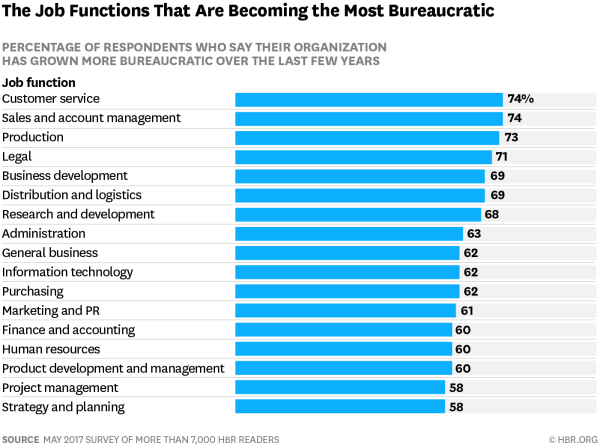
Organizations aren’t becoming flatter. Despite, all the rhetoric about holacracy and “flatarchies”, the average respondent works in an organization that has more than 6 management layers. In large organizations (more than 5,000 employees) front line employees are buried under 8 or more layers of management.
Bureaucracy is a time trap. BMI survey-takers reported spending an average of 28% of their time—more than one day a week—on bureaucratic chores such as preparing reports, attending meetings, complying with internal requests, securing sign-offs and interacting with staff functions. Moreover, a significant portion of that work seems to be creating little or no value. Less than 40% of respondents found typical bureaucratic processes (e.g. budgeting, goal-setting, performance reviews) to be “very helpful.” Another indicator of bureaucratic waste: nearly 40% of respondents said their ability to deliver value would be either unaffected or enhanced by a 30% reduction in the number of head office staffers.
Bureaucracy is the enemy of speed. Two-thirds of respondents believe that bureaucracy is a significant drag on the pace of decision-making in their organization—a number that rises to nearly 80% in large companies. Negotiating budget exceptions—often necessary when a company has to move quickly—was also impeded by bureaucracy. The average time for getting approval for an un-budgeted expenditure was 20 days or more in large organizations, versus 13 days in companies with fewer than 100 employees.
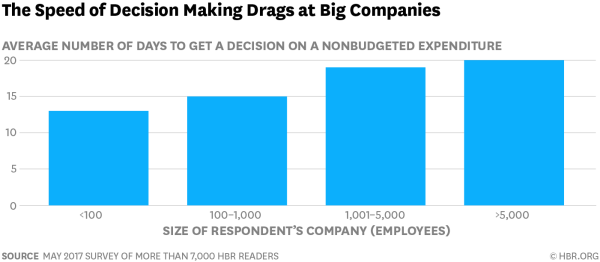
Bureaucracy produces parochialism. Survey respondents spend 42% of their time on internal issues — resolving disputes, wrangling resources, sorting out personnel issues, negotiating targets, and other tedious domestic tasks. Most swamped are executives in large companies who devote nearly half of their time to in-house matters. The worrying implication: senior leaders, who are typically charged with creating strategy, are significantly less externally focused than their subordinates. Little wonder, then, that incumbents are often slow to respond to emerging threats and opportunities.
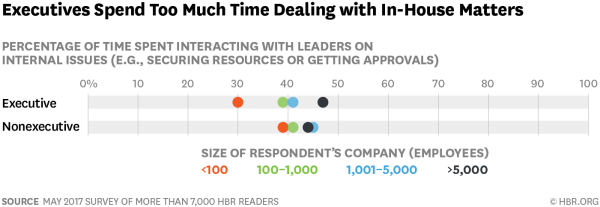
Bureaucracy undermines empowerment. When asked whether they had “substantial” or “complete” autonomy to (a) set priorities, (b) decide on work methods, and (c) choose their own boss, only 11% answered in the affirmative. In a similar vein, respondents estimated that fewer than 10% of the employees in their organizations could spend $1,000 without getting a sign-off from their boss. A further sign of disempowerment: more than three quarters of respondents indicated that front-line employees were either “never” or only “occasionally” involved in the design and development of major change initiatives. Since change that is imposed is often resisted, this lack of involvement is undoubtedly a contributor to the high failure rates of major change programs.
Bureaucracy frustrates innovation. New ideas are the lifeblood of any organization, yet only 20% of respondents said that unconventional ideas were greeted with interest or enthusiasm in their organization. Eighty percent said new ideas were likely to encounter indifference, skepticism, or outright resistance. Equally troubling is the lack of support for experimentation. Companies like Google, Amazon, Facebook, and Intuit recognize the value of bottom-up innovation and make it easy for employees to launch small-scale experiments. Not so for most of the organizations in our survey. Ninety-six percent of respondents working in companies with more than 1,000 employees said it was “not easy” or “very difficult” for a front-line employee to launch a new initiative.
Bureaucracy breeds inertia. In a bureaucracy, change programs are implemented top-down. The problem is, by the time an issue is big enough or urgent enough to capture top management’s scarce attention, the organization is already behind. Not surprisingly, nearly 60% of those surveyed said that change programs in their organization were “mostly,” or “almost always” focused on catching up. Fewer than 10% of the respondents from large companies said change programs were “mostly” or “almost always” focused on breaking new ground.
Bureaucracies are petty and political. In a formal hierarchy, competition for influence and advancement is a zero-sum game—hence the prevalence of backbiting and politicking revealed in our survey. Nearly 70% of big-company respondents indicate that political behaviors (like blame-shifting, resource hoarding, and turf battles) are “often” observed in their organizations. Overall, 64% of respondents claimed that political skills “often” or “almost always” influence who gets ahead, and in large organizations, that figure jumps to 76%. Again, while disturbing, this isn’t surprising. In a bureaucracy, power often goes to the most politically astute rather than the most competent. While we may live in the era of big data and information transparency, it seems that office politics hasn’t advanced much from the sort of noxious gamesmanship portrayed in television series like Mad Men and House of Cards.
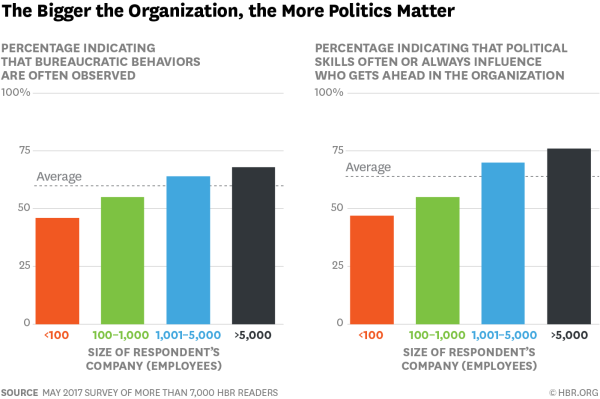
Taken as a whole, the BMI survey provides yet more evidence of the toll bureaucracy takes on productivity and resilience. It is a tax on human accomplishment. Unfortunately, though, bureaucracy won’t easily be beaten. The problem isn’t that we lack role models. Companies like Nucor, Morning Star, Spotify, Haier, and others have demonstrated that it’s possible to run large, complex organizations with a minimum of bureaucracy, and that doing so yields substantial performance advantages.
It seems that the real impediments are deeper and more personal.
When we asked survey participants to identify the most significant barriers to down-sizing bureaucracy, 57% of them pointed to the reluctance of senior executives to share power, and 50% cited the widely-held belief that bureaucracy is essential for control. These average responses, though, are misleading. While nearly two-thirds of front-line associates viewed power lust as a barrier to cutting bureaucracy, only a third of CEOs shared that view. There was a similar split around the belief that bureaucracy is critical to achieving control. While 57% of first-level employees cited this as an impediment, only 27% of CEOs expressed a similar belief. Another gap emerged when we asked respondents to reflect on the fact that bureaucracy is both familiar and entrenched. Fifty-four percent of lower-level employees saw this as barrier, compared to only 23% of CEOs. So who’s right here? Frontline employees who believe that bureaucracy is vigorously defended and deeply embedded, or senior executives who see bureaucracy as a less fearsome foe?
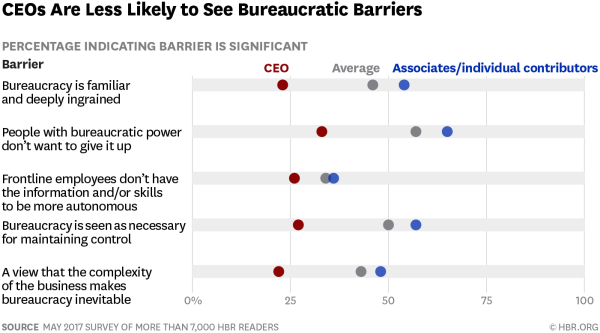
As you ponder that question, we should note that there was one area of consensus. Senior leaders and lower level employees agreed that a lack a lack of information and competence on the front lines is not a barrier to the devolution of authority and responsibility. Indeed, only 26% of CEOs and 36% of front-line employees mentioned this as an impediment—which leads to an intriguing question: If there’s a broad consensus that employees are, in fact, capable of self-management, why do they remain mired in a bureaucratic morass? Either senior leaders are more reluctant to share power and more skeptical about their employees’ capabilities than they’re willing to admit, or there are other, deeper, barriers to banishing bureaucracy.
One of these barriers may be the lack of a step-by-step guide for disassembling bureaucracy. So while many may believe that radical empowerment is possible, few know how to make that happen. Where do you start? How do you overcome pockets of resistance? How do you build the right sort of culture and values? How do you prepare individuals to take on more responsibility? What supporting changes in information systems, incentives and organizational structure are necessary? Sadly, when it comes to bureaucracy, there’s no uninstall button.
Having said that, members of our species have often ventured forth without a map. This was true for America’s founders; it was true for those in the 19th century who fought to end slavery; and it was true for those who dreamed of landing human beings on the moon. Today, it is true for those who are working to build machines that can think and emote, for those who hope to end humanity’s dependence on fossil fuels, and for those who are seeking to bridge the digital divide.
In all these cases, what propelled the pioneers forward wasn’t certainty of success, but rather the opportunity to expand the boundaries of human capability and further the cause of human dignity. These are the motivations that must be harnessed if we are to rid our organizations of the stultifying effects of bureaucracy.
In most organizations the costs of bureaucracy are largely hidden. Our accounting systems don’t measure the costs of inertia, insularity, disempowerment, and all the other forms of bureaucratic drag. Nowhere do we capture the costs of a management model that perpetuates a caste system of thinkers (managers) and doers (everyone else), that regards human beings as mere “resources,” that values conformance above all else, that squeezes people into slot-shaped roles irrespective of their innate capabilities, that swallows up human initiative in the quicksand of bureaucratic busy-work, and that regards freedom as a dangerous threat to alignment and discipline.
Measuring bureaucratic drag is a first step towards changing all this. As the size of the bureaucratic tax on human accomplishment becomes more visible, inaction will become more difficult to defend. If, as they claim, leaders are willing to share power, and if, as our respondents believe, employees are capable of exercising it wisely, then there’s no excuse for not getting on with the hard but eminently worthwhile work of dismantling bureaucracy.